Top: Krisadang Nutcharut stands Monday in the football field of Thammasat University’s Tha Prachan campus. Photo: Thiti Meetam
BANGKOK — It was from the front gate to the campus that Krisadang Nutcharut recalls the first shots fired. Not far away from the football field, where later a large explosion killed some of the thousands of students gathered.
On Monday, Krisadang toured the campus of Thammasat University, where he was just 19 on Oct. 6, 1976, when he saw his classmates assaulted, shot, murdered and mutilated before dramatically escaping into the Chao Phraya River in search of safety.
The government said 46 were killed that day. Those who were there have put the number at more than 100.
It all began when a dictator ousted three years earlier in a popular revolt quietly returned to Bangkok in the robes of a monk. The students wanted Field Marshal Thanom Kittikachorn either prosecuted or expelled, but nothing was done by the the civilian government led by Seni Pramoj.
Krisadang, a sophomore law student and member of the student council, recalled that It was at the university’s Lan Pho, or the Bodhi Lawn, where a tall tree representing the Buddha’s enlightenment was planted, that Krisadang, a sophomore law student, recalls they first gathered in protest on Oct. 4.
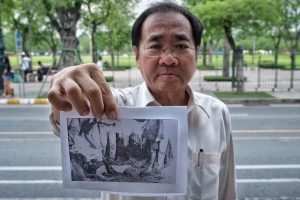
“Demands were made the Thai-language examination be canceled,” he said, as more students were urged to join the demonstration, by then numbering 400 or 500 people.
Some students staged a play which mocked the lynching of two factory workers who earlier had protested Thanom’s return.
An ominous sign came in print the next day on Oct. 5, when at least one right-wing newspaper published a photo of the play – some believed it was doctored – accusing the students of making one of the performers hanged look like HRH the Crown Prince. To this day, Krisadang accuses one English-language newspaper, The Bangkok Post, of publishing a doctored version of the photo. The paper has denied this and, at the time, did not write that the students had mocked the prince.
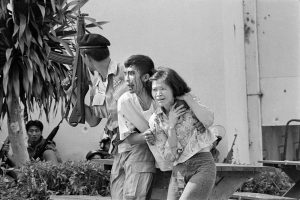
A Call to Terrible Purpose
Cold War, anti-Communist sentiments were at fever pitch, and whatever happened on the stage was seized upon as a pretext to set events in motion.
A call from the military went out over more than 200 radio stations and was heard by right-wing reactionaries, from the state-sponsored rural militia known as the Village Scouts to anti-Communist extremists established by the military called Red Gaurs. Even the military’s Housewives Association mobilized.
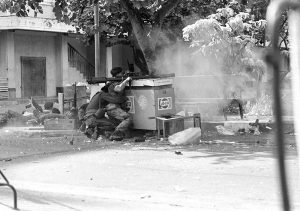
The same message was repeated again and again.
“The call was to come out and kill students,” Krisadang said was his understanding, backed by other accounts, of what was broadcast over AM radio. After all, as a famous monk had recently declared: “Killing a Communist is not a sin.”
The students soon learned that right-wing, ultra-royalist forces had gathered around the statue of King Rama V at the Royal Plaza, a 40-minute walk from Thammasat.
“By that evening, forces organized by the military arrived in front of Thammasat,” Krisadang said.
Inhumanity on Display
Forty years later, Krisadang and other members of the so-called Oct. 6 generation still try to make sense of the atrocity.
“The other side believed that we were armed Communists and had defamed the monarchy,” Krisadang said, trying to explain the raw sadism of lynching, murder, rape and torture that seemed to have no precedent.
That sadism struck the world through photographs of mad mobs leering and grinning over defiled corpses, some burned, some sexually violated and at least one with a wooden stake driven into its chest.
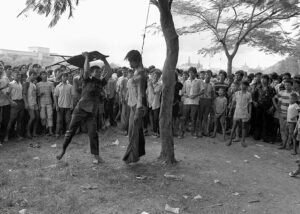
American photojournalist Neal Ulevich, working for the Associated Press, would win the Pulitzer Prize for the most remembered photo of the day.
Read: Oct. 6 Massacre: The Photographer Who Was There
In it, a student believed to be from Chulalongkorn University hangs by the neck from a tree. A barefoot man visibly exerts himself as he swings a folded metal chair downward to strike the body. Some faces in the crowd look horrified, yet many more beam with smiles and laughter.
Krisadang said he had no idea the paramilitary mob was capable of unleashing such hatred and violence. He faults political passions being whipped up to divide people and make them turn on one another.
“It came to a point where the ruling class felt they couldn’t let go of their power and believed Thailand would be the next ‘fallen domino,’” he said, referring to the Cold War jingoism that saw communism as an existential threat to the free world.
Krisadang said anyone who was seen as a political opponent was branded a Communist and anti-monarchist.
“It’s like now how people have been divided into yellow and red shirts,” he said. “Are we going to continue to be used as pawns?”
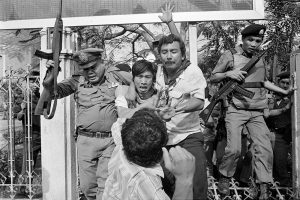
October 6
One man who claims he knew in advance the students were doomed was Jaran Ditapichai, then 29. Jaran was a mid-ranking Communist Party member dispatched to Thammasat University to save those “important” lives he could. He failed and barely managed to save himself.
“I entered because I was worried and wanted to offer suggestions,” Jaran said. “Some should be spared. Not all should be arrested or killed. My intelligence liaison told me I should leave immediately, however, saying they were going in for the kill tonight.”
By the night of Oct. 5, Jaran had heard border patrol police had occupied the National Museum compound on the north of the university.
Later that night, witnesses such as Jaran and Krisadang recall hearing shots fired intermittently.
Just before dawn on Oct. 6 came a signal things of what was to come.
Someone fired either a mortar shell or M79 grenade into the campus’ football field, where Krisadang estimates some 2,000 to 3,000 people, mostly students, were gathered.
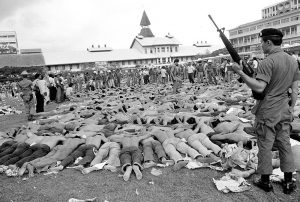
The explosions instantly killed students where it hit and shook the buildings inside the historic university, once a command center for the Thai resistance movement against Japanese occupation during World War II.
“Many were killed,” Krisadang said. “Then we heard gunshots coming from Wat Mahathat,” he said, referring to a temple on the south side of the university.
Two student leaders on stage, Thongchai Winichakul and Somsak Jeamteerasakul, called futilely for the attack to stop, Krisadang said.
By 5am, gunfire erupted from the direction of the National Museum.
Jaran said several people around him were gunned down and killed. He said it was only by luck that he fell to a spot of lower ground – not the footpath or the football field where others were being shot – where he was shielded from the bullets.
“I smelled blood mixed with brains in the air,” he said. “Two or three people were lying dead.”
About the time the sun rose, two or three buses plowed through the gate of the university. That’s when Krisadang fled west from the gate toward the Chao Phraya River. It was low tide when he stumbled into the water, and he waded and swam south to the Tha Prachan Pier, where a kindly Thai-Chinese shopkeeper hid him.
Jaran made his way south across campus to the Faculty of Social Administration. He found a way into the basement and hid there overnight. He was arrested the following morning after soldiers noticed his footprints.
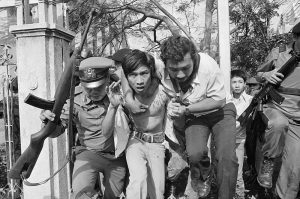
Making of a Massacre
Jaran managed to escape after a few days when a guard forgot to lock his cell, then fled into the jungle to join other members of the Communist Party of Thailand in hiding. Today he lives in exile in Paris, where he remains to avoid prosecution on a charge of insulting the royal family.
He notes that most of those who had gathered at Thammasat to protest Thanom were not communists. But he also thinks it’s time history shows there were communists present four decades ago.
He said the status quo saw them as a threat.
“Too many students and people were becoming ‘red’ too soon, and the ruling class became fearful, leading to the call for a total crackdown,” Jaran said.
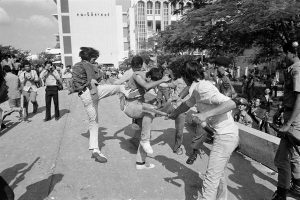
He faults a persistent media campaign which demonized students and citizens for playing a major role. He compared it to the vilification of Redshirts today by the right-wing press.
“It went on until people lost their basic conscience, believing that all were communists, were demons, and that there was no sin in killing them. It was these decisive factors that led to Oct. 6,” he said.
The massacre should also be remembered for enabling a military coup later the same day, he said, just three years after the public had risen up to drive out a military dictatorship.
Untreated Trauma
Vipa Daomanee, then a 21-year-old Chulalongkorn University student and part of the Oct. 6 generation, was not present but remains deeply affected by what happened.
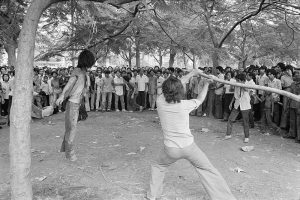
Vipa was on her campus drafting the last statement by the Students’ Confederation of Thailand at 1am on Oct. 6 while some of her friends were being murdered. It weighs on her that nobody has ever been held responsible for the atrocity, even after 40 years.
Attempts to bury it with the past have just made the wound fester, she said.
“It was a state crime wherein the ruling class used violence against its opponents,” Vipa said. “It has become a wound in society that has yet to heal.”
Sinsawat Yodbantoey, like Vipa and Krisadang, has actively commemorated the massacre for decades. He’s among those who see the massacre’s lessons as yet unlearned and unregistered in Thailand’s collective memory.
“There are things that have been recorded, and there are things that have been forgotten. There are selective memories and selective forgetting. This results in confusion,” Sinsawat said.
Sinsawat was a 22-year-old art student at Pho Chang College. He was saved that day by a childhood friend who had joined the Village Scouts and recognized him.
No commission has ever been established to gather evidence about who masterminded the massacre. It wasn’t until 2000 that an effort to build a small memorial on the campus prevailed.
Sinsawat said those in power today still do not want this episode of Thai history remembered.
“We have yet to be able to find evidence to launch a lawsuit, saying this or that person made the order,” Sinsawat said.
On the brighter side, Sinsawat said there’s renewed interest among young people in the issue as a result of the 2014 military coup.
While Krisadang was giving his tour of the campus on Monday, two young people were there taking photos, curious to learn about the incident.
As for Jaran, the man acknowledges that attempts to make Oct. 6 a collective memory have been a part – but not total – failure.
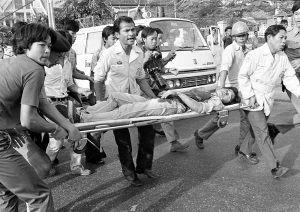
“The first 20 years was a period when nobody was willing to speak or write about it. People were still afraid,” said Jaran, the 69-year-old political exile said from Paris. A Redshirt leader, he fled the kingdom in 2014 after the coup and obtained asylum status in France.
“Oct. 6 is about defeat, and people try not to discuss it because of that. There’s also the allegations they were communists, and that made them even more reluctant to talk,” he said in an interview over the telephone.
“The ruling class and the military want us to forget while the other side is struggling for people to remember,” Jaran said. “Those who want to forget may forget, but I shall never. I was almost killed.”
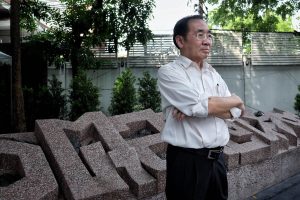
Collective Amnesia
There are forces suppressing knowledge and memory of that day that go beyond those responsible wanting it forgotten.
Today, with the massacre unmentioned in the classroom or textbook, Sinsawat said some university students can’t comprehend the cruelty depicted in the photographs. Some even doubt it happened.
“Some think it can’t be real, as if the picture must have been photoshopped,” he said.
Other youth simply refuse to engage with the issue, saying the topic is “too heavy.”
Krisadang and Vipa said there are others who just don’t want the orgy of violence and murder known publicly.
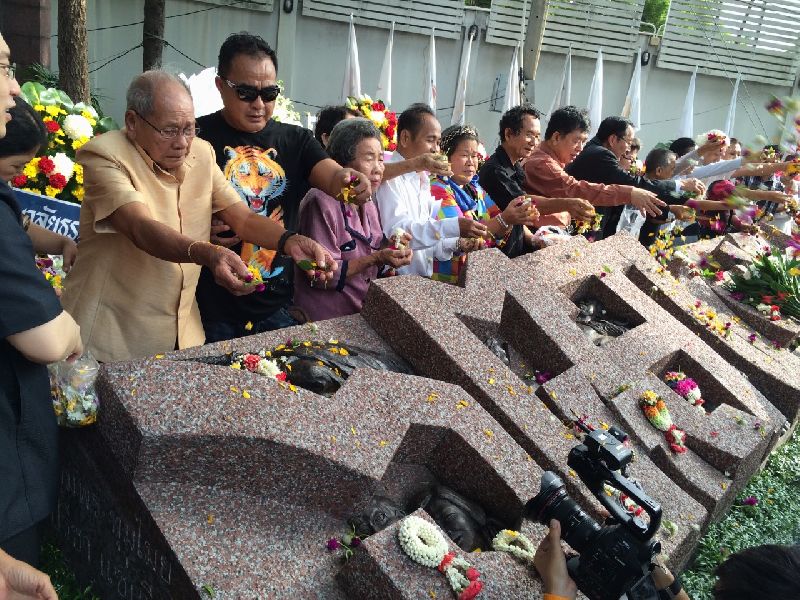
Forty years on, Vipa said some relatives of those killed are still unwilling to speak publicly. The Oct. 6 generation has its own infighting and bad blood, and those trying to chronicle what was arguably the cruelest episode of modern Thai history quibble over whether just two, four, or even five people were hanged by the mob that day.
Despite that, Vipa, who’s known for emotional outbursts when it comes time to commemorate the event, said there’s a power in the sheer fact 40 years have passed.
She said more people have become interested in what happened, with events planned in at least three universities.
“The number 40 is powerful. Those who should have become interested about the issue earlier and have not are now becoming curious,” said Vipa, who eventually became an academic before retiring. “We need to be reminded and keep holding the commemoration every year. No matter how many people show up, we must stress and link it to the present.”
Even more attention was called when Thai authorities on Wednesday detained a 19-year-old pro-democracy leader from Hong Kong who was invited to an event on the anniversary tomorrow to commemorate the massacre. Joshua Wong was held for some hours before being deported back home.
As for those who were there such as Krisadang, there are still new things to learn.
As he walked through Thammasat reminiscing about the past on Monday, he said just last year a friend and fellow member of the Oct. 6 generation, historian Thongchai Winichakul, was able to pin down one elusive detail. On the campus, one of the tamarind trees growing there, he concluded, once bore the weight of a murdered student left hanging beneath it.










































